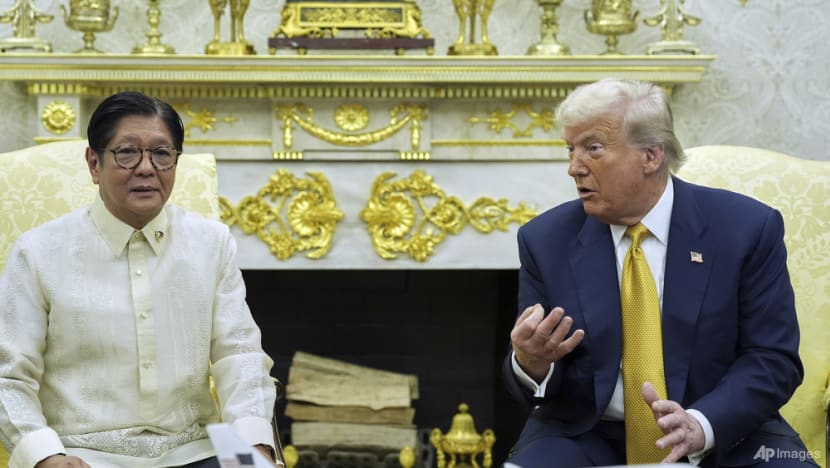Commentary: Trump’s tariff deal with the Philippines was all praise, little gain
For all the praise that the US president lavished on his Philippine counterpart, Marcos Jr had little to account for from his high-profile visit to the US, say these academics.

US President Donald Trump and Philippine President Ferdinand Marcos Jr in the Oval Office of the White House, Jul 22, 2025. (AP Photo/Alex Brandon)
QUEZON CITY, Philippines: On Jul 22, Philippine President Ferdinand Marcos Jr met US President Donald Trump in the White House. High on the agenda was the securing of a lower tariff rate for the Philippines.
In the end, all that President Marcos Jr got from what appeared to be a robust and warm exchange with Trump was a 1 percentage point reduction in tariffs imposed on the country by the US. This suggests that Manila, which has sought to diversify its security relations beyond Washington, should do likewise for its economic ties.
In a social media post, Trump announced that Marcos’ White House visit was “beautiful”, and that he was a “very tough negotiator”.
But Trump also announced that the Philippines hardly budged in trade negotiations. As a result, it will pay a 19 per cent tariff, just 1 percentage point lower than the 20 per cent indicated in a letter sent to Marcos Jr on Jul 9. This was higher than the 17 per cent tariff stipulated in April.
The turn of events does not speak well of the Trump 2.0 administration’s overall appreciation of Philippines-US relations. Marcos was able to secure continued cooperation on defence and strategic matters, including the building of an ammunition facility in Subic, a former US naval base. Renewed US commitments to the ironclad alliance between the two countries were not reflected in the tariff reduction of just 1 percentage point.
LACK OF RECIPROCITY IN TRUMP’S TARIFFS
Trump also announced (in his inimitable capitalisation style, or lack thereof) that “The Philippines is going OPEN MARKET with the United States, and ZERO Tariffs”. Marcos clarified that this applies to automobiles imported from the US, so that automobiles imported by the Philippines from the US will now have zero tariffs. It remains unclear whether this applies to other products as well.
On the one hand, this might benefit Filipinos because some things they import from the US will be possibly cheaper. But this highlights the yawning lack of reciprocity in Trump’s tariffs. If the Philippines is not imposing tariffs on US goods, the US should also reduce most tariffs on Philippine exports to the US.
Then again, Trump has a totally warped notion of tariffs to begin with. Back in April, economists noted that the original tariff rates were not even related to the true extent of effective tariff rates set by various countries in the US.
The Philippines, for example, imposed in 2024 an average Most Favoured Nation tariff on US imports of 6 per cent: 9.5 per cent for agricultural goods and 5.4 per cent for non-agricultural goods. Trump’s tariff rate on the Philippines of 17 per cent (now 19 per cent) is not commensurate.
Trump still fails to realise that tariffs are paid not by other countries but by American consumers. Consequently, Americans should brace for higher inflation. While April and May inflation remained muted, economists warn that inflation will skyrocket once Trump’s tariffs are pushed through.
Another round of US inflation spikes (similar to what happened in 2022) does not bode well for the Philippine economy and the rest of ASEAN. This will likely result in an increase in interest rates. This is exactly what ASEAN central banks did between 2022 and 2023. More worryingly, another round of interest rate hikes, sooner or later, will dampen already weak regional economic growth.
WHAT’S NEXT FOR THE PHILIPPINES
So, what now for the Philippines? The 19 per cent tariff rate is still lower than what other neighbouring ASEAN economies got. Vietnam got 20 per cent and Indonesia 19 per cent. Both rates are significantly lower than the April rates of 40 per cent and 32 per cent, respectively. The two countries, which are not formal military allies of Washington, fared better in their negotiations with the US compared to the Philippines, a formal US treaty ally.
Nevertheless, the US remains the biggest destination of Philippine exports (about 17 per cent of total exports), and the semiconductor industry is likely to be hit significantly. It would have been better if Marcos Jr had been able to secure a tariff exemption on Philippine semiconductors. Still, other vulnerable sectors include garments, food, and agricultural products – as suggested by the experience during the trade war during the first Trump administration.
Looking for a silver lining, the Philippine government hopes that some trade from higher-tariffed countries may be diverted to the Philippines because of the country’s relatively lower tariff rate. But this is unlikely given the country’s lack of competitiveness.
This is due to ongoing deficits in the country’s logistics and transportation infrastructure, overreliance on low value-added parts of global value chains, and worrying gaps in human capital. During the previous Trump administration’s trade war, these constraints did not help the Philippines become an alternative trade partner and investment destination.
On Monday (Jul 28), Marcos Jr will deliver his fourth State of the Nation Address, and he is likely to brag about the profuse praise he got from Trump as well as the new tariff rate. With the Philippines ending up with an even higher tariff than in April, that hardly points to Marcos being a “very good, very tough” negotiator.
The outcome of the US trip should serve as a powerful signal to the Marcos Jr administration. As it started to diversify its security relations beyond the US alliance by deepening cooperation with middle powers such as Japan and Australia, it must do the same to promote its economic interests. Under Trump 2.0, it might be wise for the Philippines not to put all its economic eggs in the US basket.
JC Punongbayan is an assistant professor at the University of the Philippines School of Economics and Aries A Arugay is Visiting Senior Fellow and Coordinator of the Philippine Studies Programme at ISEAS – Yusof Ishak Institute. This commentary first appeared on ISEAS – Yusof Ishak Institute’s blog, Fulcrum.


















